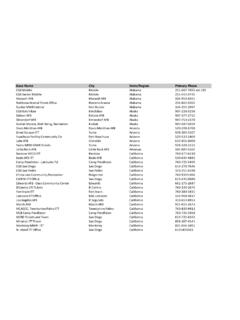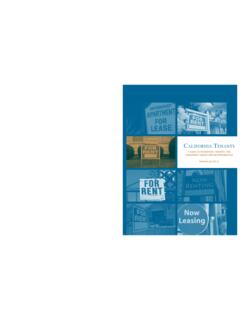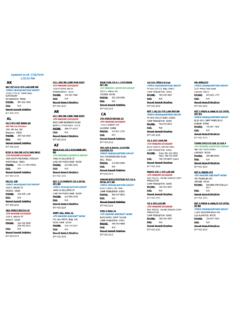Transcription of CARAVAN & MOBILE HOME PARKS - FIRE SAFETY …
1 CARAVAN & MOBILE home PARKS - FIRE SAFETY GUIDANCE FOR SITE OPERATORS. There are a growing number of MOBILE home sites across Scotland, spread across 32 local authority areas. An increasing number of people, many of whom are elderly, live permanently in MOBILE homes or park homes. While many sites are well run, there is evidence that some site owners require guidance to enable compliance with the Fire (Scotland) Act 2005 and the Fire SAFETY (Scotland) Regulations 2006. The Scottish Fire and Rescue Service are the enforcing authority for fire SAFETY in all of CARAVAN and camping sites to which this Guidance document pertains, where relevant. Fire SAFETY Risk Assessments 1. Before a site is occupied a full Fire SAFETY Risk Assessment should be completed in accordance with Section 54 and Schedule 2 of the Fire (Scotland) Act 2005 and the Fire SAFETY (Scotland) Regulations 2006.
2 Fire SAFETY risk assessment should be the foundation for all the fire SAFETY measures. The Fire SAFETY Risk Assessment should be carried out by someone with sufficient technical knowledge. In this respect, the Scottish Fire and Rescue Service, as the Enforcing Authority of the aforementioned legislation, cannot undertake the role. 2. All other relevant premises buildings and permanent structures within the site, (under the Fire (Scotland) Act 2005), should be subject to an individual fire SAFETY risk assessment. These buildings/structures may fall under different uses, for example Offices, Shops and Similar Premises, Entertainment and Assembly, or Premises Providing Sleeping Accommodation, which may be small, medium or large. For further information on fire SAFETY risk assessment and sector specific guidance documents go to: 3. If it is decided to employ a fire SAFETY specialist, it can be difficult to judge the competence of companies and persons who advertise their services as fire risk assessors.
3 There are registration schemes in operation for persons and companies that carry out fire risk assessments. Details of registration and certification schemes are listed in a guidance document on the website of the Fire Sector Federation. Fire and Rescue Service Access 4. Vehicle access must be provided to at least one or more elevations/sides of any buildings and permanent structures within the CARAVAN and MOBILE home sites, where principal entrance or entrances are provided. Emergency vehicle routes must be kept clear at all times. Roadways provided and intended for fire service access should be capable of supporting the weight of a 14 tonne fire appliance and be adequately maintained. Any gateways should be a minimum of m wide and high. No overhead cables should be permitted below above the ground where they cross Fire and Rescue Service access routes.
4 Vehicle access routes to more 1. than one elevation may not always be possible due to the constraints of the site. Where this is the case then pedestrian access for Fire and Rescue Service personnel should be provided which consists of a paved (or equivalent) footpath at least 900. mm wide to the principal entrance, or entrances, of the building. 5. Every elevation which is provided with vehicle or pedestrian access for Fire and Rescue Service personnel should have a door giving access to the interior of the building. 6. Where any compartment exceeds 900 m2, or the building footprint has a perimeter greater than 150 metres, then access should be provided to the other elevations/sides of the building. 7. Fire and Rescue Service vehicles should not have to reverse more than 20 metres from the end of an access road. Where any dead-end route is more than 20 metres long, turning facilities should be provided.
5 A hammer-head or turning circle with a minimum of metres between the kerbs should be provided. Following consultation with the Fire and Rescue Service, it may be recommended that an operating space, or spaces, for a high reach appliance be provided. 8. Fire and Rescue Service access and hard standing should be maintained to within 60. metres of the most remote CARAVAN or unit. Water Supply for Fire and Rescue Service Use 9. Where buildings and permanent structures are located on CARAVAN and MOBILE home sites at least one external water hydrant should be provided as a means for fighting fire on every site. This is a minimum requirement and consultation should be made with the Fire & Rescue Service as to the adequacy of supplies to each site. It may be that a single hydrant may facilitate a small site however larger sites that cover greater areas may require to have additional water supplies provided.
6 Hydrants should be positioned so that there is one not more than 60 metres from at least one normal entrance to the building and every external elevation/side of the building is within 60. metres of a hydrant. Where hydrants are provided for the protection of caravans, they should be sited within 100m of each CARAVAN standing. Hydrants should be: At least 6 metres from a building;. Located adjacent to a parking space for a pumping appliance;. Accessible for use at all times; Located so that there is a clear route for the fire hose between the hydrant and the building; and Constructed in accordance with BS 750. Marked with a suitable H sign in accordance with BS 3251. Where appropriate, maintained in accordance with BS 9990: 2015 or equivalent. 10. Localised areas throughout Scotland may not be supplied by mains water or, where mains water is available, the pressure and flow rates in the main may not be sufficient for fire-fighting operations.
7 11. Where no piped water supply is available, or there is insufficient pressure and flow in the water main, or an alternative arrangement is proposed, the alternative source of supply should be provided in accordance with the following recommendations: A charged static water tank of at least 45,000 litre capacity; (this may be reduced after assessment and consultation with SFRS). 2. A spring, river, canal, loch or pond capable of providing or storing at least 45,000 litres of water at all times of the year, to which access, space and a hard standing are available for a fire service pumping appliance; or Any other means of providing a water supply for fire-fighting operations considered appropriate, agreed in consultation, with the Scottish Fire and Rescue Service Water Planning Department and other relevant authorities. Spacing of Caravans, MOBILE Homes or Portable Units on Site 12.
8 The distance between any two caravans/ MOBILE homes (or any other structure). should not be less than 6 metres. 13. Where existing variations are in place regarding the distance between units in relation to combustible materials used in any construction, it should be requested that the unit owners replace with non-combustible materials. When a unit tenancy changes the default of a 6 metre distance regarding the above should be reinstated as part of the new tenancy agreement. This will also be the case when a unit is removed or replaced. 14. Any variation to 6 metre distance between units must be in consultation with the Scottish Fire and Rescue Service. 15. The distance from any part of the CARAVAN / MOBILE home to any site road should be not less than 2 metres and not less than 3 metres from any site boundary. 16. Measurement for the following variations of spacing requirements is taken from the exterior cladding (excluding any tow bar): Porches may protrude 1 metre into the 6 metres and should be open type construction.
9 Where awnings are used, the distance between any part of the awning and an adjoining CARAVAN should be not less than 3 metres. The awnings should not incorporate sleeping accommodation and they should not face each other or touch; not applicable on MOBILE home sites;. Eaves, drainpipes and bay windows may extend into the 6 m space provided the total distance between the extremities of two adjacent units is not less than metres;. If there are ramps for disabled persons, verandas (including decking) or stairs extending from the unit, there should be metres clear space between them and two such items should not face each other in any space. If they are enclosed, they should normally be considered as part of the unit and, as such, should not intrude at all into the 6 metres space; and A garage, shed or covered space may be permitted between units only if of non-combustible construction and enough space is maintained around each unit so not to prejudice means of escape in case of fire.
10 Any windows in such structures should not face towards the units on either side. Car ports and covered walkways should in no circumstances be allowed within the 6 metres space. A risk based approach should be applied where existing units are located next to utilities such as electrical substations, sewage treatments works, bulk 3. gas or oil storage tanks, water storage tanks, laundry or social facilities premises. It is envisaged that via the fire SAFETY risk assessment process, a safe distance or any alternative arrangements can be put in place to ensure compliance. Car Parking 17. One car only should be permitted to park between adjoining caravans/ MOBILE homes subject to the entrance to the unit not being obstructed. Plastic/wooden boats should not be kept between units. 18. No car parking area providing parking for more than 10 cars should be nearer than 18 metres from any part of a unit.







